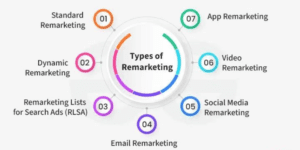Where countless products and services vie for attention, it’s easy for potential customers to slip through the cracks. This is where remarketing comes into play. Remarketing, a strategic approach in digital marketing, allows businesses to re-engage with users who have previously interacted with their website or mobile app. It’s like giving a gentle nudge to those who have shown interest but haven’t made a purchase or taken a desired action. Let’s go deeper into what remarketing entails, why it’s essential, and explore its various types.
Suppose a user visits your online store, browses through your products, but leaves without making a purchase. Without remarketing, chances are high that they might forget about your brand amidst the digital noise. However, by implementing remarketing strategies, you can stay top-of-mind and guide these potential customers back to your website, ultimately increasing conversion rates and maximizing your marketing efforts.
Who Should Utilize Remarketing
Remarketing isn’t limited to large corporations with hefty marketing budgets. In fact, businesses of all sizes and across industries can benefit from remarketing campaigns.
Whether you’re an e-commerce store looking to recover abandoned carts, a B2B company aiming to nurture leads, or a service provider seeking to boost sign-ups, remarketing can be tailored to suit your specific goals and target audience.
Remarketing and their Types

Standard Remarketing
This is the most common type of remarketing, where ads are displayed to users who have previously visited your website as they browse other websites or use apps within the Google Display Network.
For Example, any user visits an online clothing store to browse for dresses but leaves without making a purchase. Later, as she browses through her favorite blog, she notices ads from the same clothing store featuring the dresses she viewed earlier. This is standard remarketing in action, reminding user about the products she showed interest in and encouraging her to revisit the store to make a purchase.
Dynamic Remarketing
Dynamic remarketing takes personalization to the next level by displaying ads featuring specific products or services that users viewed on your website.
For Example, Priya visits an online electronics retailer to check out the latest smartphones. He views several models but leaves without making a purchase. Later, while scrolling through a news website, he sees ads from the same retailer showcasing the exact smartphones he viewed, along with personalized recommendations based on his browsing history. Dynamic remarketing dynamically adjusts the ads to display products tailored to Priya’s interests, increasing the likelihood of conversion.
Remarketing Lists for Search Ads (RLSA)
RLSA allows you to customize your search ads and bids for users who have previously visited your website.
For Example, a person searches for “best running shoes” on Google and clicks on a website that sells athletic gear but doesn’t make a purchase. Later, when she searches for “running shoes” again, she sees ads from the same website with a special discount for returning visitors. RLSA allows the website to customize its search ads and bids for users who have previously visited the site, increasing the chances of conversion.
Video Remarketing
Video remarketing involves reconnecting with users who have engaged with your videos or YouTube channel.
For Example, a company watches a video tutorial on photography tips from a camera brand’s YouTube channel but doesn’t make a purchase. Later, while watching other videos on YouTube, they sees ads from the same brand showcasing the latest camera models and accessories. Video remarketing keeps the brand top-of-mind, encouraging them to explore their products further and potentially make a purchase.
Social Media Remarketing
With the majority of internet users active on social media platforms, social media remarketing is a valuable tool for staying connected with your audience.
For Example, Mrunal follows a beauty brand on Instagram and occasionally visits their website to browse new makeup releases. After leaving the website without making a purchase, she sees sponsored posts from the same brand while scrolling through her Instagram feed, featuring the products she viewed earlier. Social media remarketing leverages user engagement with the brand on social media to deliver targeted ads and encourage her to make a purchase.
Remarketing serves as a powerful tool in the digital marketer’s arsenal, enabling businesses to rekindle interest, reinforce brand awareness, and ultimately drive conversions. Whether you opt for standard remarketing, dynamic remarketing, or explore other types, incorporating remarketing into your marketing strategy can yield significant returns on investment and help you stay ahead in today’s competitive landscape. Want to get it done by experts? Contact us then!



Comments are closed